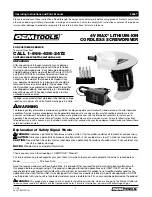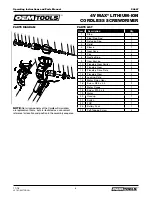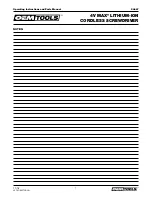
4
Operating Instructions and Parts Manual
24667
11/18
2018 OEMTOOLS
™
4V MAX* LITHIUM-ION
CORDLESS SCREWDRIVER
PREPARING SCREW HOLES
It is important to prepare screw holes before attempting
to fasten two pieces of wood together. Proper preparation
will make screws drive easier and prevent misaligned
components, stripped screw heads, splitting, and
separating of wood components.
1. Clamp components that are to be screwed together in
their desired position (Fig. 5).
2. Drill a pilot hole (1) through the outer piece (2) and into
the inner piece (3). Drill hole 2/3 the diameter of the
smooth portion of the screw shank.
NOTE
: If the wood is soft, drill the hole 2/3 the length of
the screw. If the wood is hard, drill the hole the full length
of the screw.
3. Remove the clamp from the two pieces to be screwed
together.
4. Enlarge the hole (1) in the outer piece (2) so that it is the
same size as the smooth portion of the screw shank (Fig. 6).
5. If using a flat head screw, counter-sink the hole (4) so
the head of the screw will be flush with the surface
when fully driven into place.
Fig. 5
Figure 5
Fig. 6
Figure 6
LITHIUM-ION BATTERY PERFORMANCE
Lithium-ion rechargeable batteries generally provide
superior performance to nickel-cadmium batteries when
used in power tools.
• Faster charges
• Longer battery life
• More power
• Lighter weight
Lithium-ion batteries perform best and deliver peak
output power at room temperature (20° C or 68° F). When
operated in lower temperatures, the battery output will
be reduced and it will NOT function below –20° C (-4° F).
At higher temperatures, output power will increase as the
heat generated by the battery during use increases the
internal temperature of the battery. The result is increased
power as the tool is used.
DRIVING SCREWS
When driving screws, care must be taken to use the bit
that correctly fits the head of the screw being driven.
Make sure you use the largest bit size that will properly fit
into the head of the screw. The bits must also be in good
condition and not worn so they will drive screws without
slipping out of the screw head.
1. Select the correct screwdriver bit for the screw being
driven.
2. Insert the bit (1) fully into the screwdriver collet (2) (Fig. 7).
3. Insert the screwdriver bit fully into the screw head (3).
4. While holding the screwdriver firmly against the screw
and the bit aligned with the screw, press the upper part
of the switch to start the screwdriver and drive the screw.
5. When the screw is driven to the correct depth, release
the switch and the screwdriver will stop.
6. When the switch is released and the screwdriver stops
turning, the spindle will automatically lock. Fully tighten
the screw by manually rotating the screwdriver handle
in a clockwise direction.
7. To remove screws, follow the same general procedure
as for driving screws. When starting the screwdriver,
press on the lower part of the switch.
Fig. 7
Figure 7
GENERAL MAINTENANCE
WARNING
:
When servicing, use only identical replacement parts.
The use of any other part may create a hazard or cause
product damage.
DO NOT use solvents when cleaning plastic parts.
Plastics are susceptible to damage from various types of
commercial solvents and may be damaged by their use.
Use a clean cloth to remove dirt, dust, oil, grease, etc.
WARNING
:
DO NOT allow brake fluids, gasoline, petroleum-based
products, penetrating oils, etc. to come into contact with
plastic parts. They contain chemicals that can damage,
weaken or destroy plastic.
DO NOT abuse power tools. Abusive practices can
damage the tool and the workpiece.


























